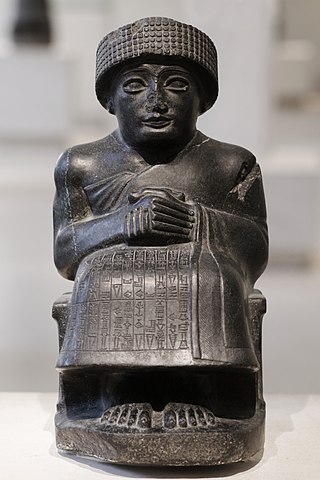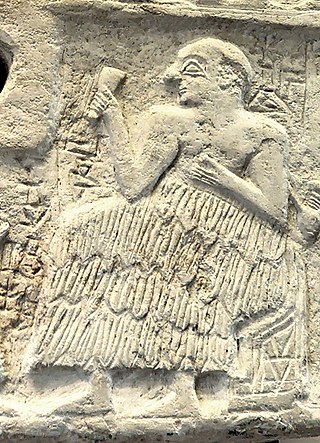
The Akkadian Empire was the first ancient empire of Mesopotamia after the long-lived civilization of Sumer. It was centered in the city of Akkad and its surrounding region. The empire united Akkadian and Sumerian speakers under one rule. The Akkadian Empire exercised influence across Mesopotamia, the Levant, and Anatolia, sending military expeditions as far south as Dilmun and Magan in the Arabian Peninsula.
The 22nd century BC are the years between 2200 and 2101 years before the birth of Jesus Christ.
Lagash was an ancient city state located northwest of the junction of the Euphrates and Tigris rivers and east of Uruk, about 22 kilometres (14 mi) east of the modern town of Al-Shatrah, Iraq. Lagash was one of the oldest cities of the Ancient Near East. The ancient site of Nina is around 10 km (6.2 mi) away and marks the southern limit of the state. Nearby Girsu, about 25 km (16 mi) northwest of Lagash, was the religious center of the Lagash state. The Lagash state's main temple was the E-ninnu at Girsu, dedicated to the god Ningirsu. The Lagash state incorporated the ancient cities of Lagash, Girsu, Nina.

Gudea (Sumerian: 𒅗𒌤𒀀, Gu3-de2-a) was a ruler (ensi) of the state of Lagash in Southern Mesopotamia, who ruled c. 2080–2060 BC (short chronology) or 2144-2124 BC (middle chronology). He probably did not come from the city, but had married Ninalla, daughter of the ruler Ur-Baba (2164–2144 BC) of Lagash, thus gaining entrance to the royal house of Lagash. He was succeeded by his son Ur-Ningirsu. Gudea ruled at a time when the center of Sumer was ruled by the Gutian dynasty, and when Ishtup-Ilum ruled to the north in Mari. Under Gudea, Lagash had a golden age, and seemed to enjoy a high level of independence from the Gutians.

Ur-Nanshe also Ur-Nina, was the first king of the First Dynasty of Lagash in the Sumerian Early Dynastic Period III. He is known through inscriptions to have commissioned many buildings projects, including canals and temples, in the state of Lagash, and defending Lagash from its rival state Umma. He was probably not from royal lineage, being the son of Gunidu who was recorded without an accompanying royal title. He was the father of Akurgal, who succeeded him, and grandfather of Eanatum. Eanatum expanded the kingdom of Lagash by defeating Umma as illustrated in the Stele of the Vultures and continue building and renovation of Ur-Nanshe's original buildings.

Ningishzida was a Mesopotamian deity of vegetation, the underworld and sometimes war. He was commonly associated with snakes. Like Dumuzi, he was believed to spend a part of the year in the land of the dead. He also shared many of his functions with his father Ninazu.

Girsu was a city of ancient Sumer, situated some 25 km (16 mi) northwest of Lagash, at the site of modern Tell Telloh, Dhi Qar Governorate, Iraq.

Entemena, also called Enmetena, lived circa 2400 BC, was a son of En-anna-tum I, and he reestablished Lagash as a power in Sumer. He defeated Il, king of Umma, in a territorial conflict through an alliance with Lugal-kinishe-dudu of Uruk, successor to Enshakushanna, who is in the king list. The tutelary deity Shul-utula was his personal deity. His reign lasted at least 19 years.

Enannatum I, son of Akurgal, succeeded his brother E-anna-tum as Ensi of Lagash. During his rule, Umma once more asserted independence under its ensi Ur-Lumma, who attacked Lagash unsuccessfully. After several battles, En-an-na-túm I finally defeated Ur-Lumma. Ur-Lumma was replaced by a priest-king, Illi, who also attacked Lagash.

The Early Dynastic period is an archaeological culture in Mesopotamia that is generally dated to c. 2900 – c. 2350 BC and was preceded by the Uruk and Jemdet Nasr periods. It saw the development of writing and the formation of the first cities and states. The ED itself was characterized by the existence of multiple city-states: small states with a relatively simple structure that developed and solidified over time. This development ultimately led to the unification of much of Mesopotamia under the rule of Sargon, the first monarch of the Akkadian Empire. Despite this political fragmentation, the ED city-states shared a relatively homogeneous material culture. Sumerian cities such as Uruk, Ur, Lagash, Umma, and Nippur located in Lower Mesopotamia were very powerful and influential. To the north and west stretched states centered on cities such as Kish, Mari, Nagar, and Ebla.
Gatumdug was a Mesopotamian goddess regarded as the tutelary deity of Lagash and closely associated with its kings. She was initially worshiped only in this city and in NINA, but during the reign of Gudea a temple was built for her in Girsu. She appears in a number of literary compositions, including the hymn inscribed on the Gudea cylinders and Lament for Sumer and Ur.

The Department of the Middle East, numbering some 330,000 works, forms a significant part of the collections of the British Museum, and the world's largest collection of Mesopotamian antiquities outside Iraq. The collections represent the civilisations of the ancient Near East and its adjacent areas.
The E-ninnu 𒂍𒐐 was the E (temple) to the warrior god Ningirsu in the Sumerian city of Girsu in southern Mesopotamia. Girsu was the religious centre of a state that was named Lagash after its most populous city, which lay 25 km southeast of Girsu. Rulers of Lagash who contributed to the structure of the E-ninnu included Ur-Nanshe of Lagash in the late 26th century BC, his grandson Eannatum in the following century, Urukagina in the 24th century and Gudea, ruler of Lagash in the mid 22nd century BC.

The Gudea cylinders are a pair of terracotta cylinders dating to c. 2125 BC, on which is written in cuneiform a Sumerian myth called the Building of Ningirsu's temple. The cylinders were made by Gudea, the ruler of Lagash, and were found in 1877 during excavations at Telloh, Iraq and are now displayed in the Louvre in Paris, France. They are the largest cuneiform cylinders yet discovered and contain the longest known text written in the Sumerian language.

Neo-Sumerian art is a period in the art of Mesopotamia made during the Third Dynasty of Ur or Neo-Sumerian period, c. 2112 BC – c. 2004 BC, in Southern Mesopotamia. It is known mostly for the revival of the Sumerian stylistic qualities and was centered around royalty and divinity.

Ur-Baba or Ur-Bau (Sumerian: 𒌨𒀭𒁀𒌑ur-Dba.ba6 or ur-Dba.U2, servant of the goddess Bau) was ensi of Lagash from 2093 BC – 2080 BC (short chronology) or 2157 BC – 2144 BC (middle chronology), roughly contemporaneous with the last king of Akkad, Shu-turul. In one of his inscriptions, he refers to himself as a child of the god Ninagal (Sumerian: 𒀭𒎏𒀉𒃲).

Ur-Ningirsu also Ur-Ningirsu II in contrast with the earlier Ur-Ningirsu I, was a Sumerian ruler (ensi) of the state of Lagash in Southern Mesopotamia who ruled c. 2110 BC. He was the son of the previous ruler of Lagash named Gudea.
Nam-mahani was a Sumerian ruler, and the last ensi of Lagash circa 2100 BCE, roughly contemporaneous with the last king of Akkad, Shu-turul. His reign was followed by that of Utu-hengal, who destroyed the power of the Gutian Dynasty, and put and end to the power of the various city-states, reunifying the Sumerian realm.
Ur-Ningirsu I, was a Sumerian ruler (ensi) of the state of Lagash in Southern Mesopotamia who ruled c. 2200 BCE. He is much less known and documented than Ur-Ningirsu II, generally just called Ur-Ningirsu.

Igalim or Igalimma was a Mesopotamian god from the local pantheon of the state of Lagash. He was closely associated with Ningirsu, possibly originating as the personification of the door of his temple, and was regarded as a member of his family. His older brother was Shulshaga and his mother was Bau, as already attested in Early Dynastic sources. Until the end of the Ur III period he was worshiped in Lagash and Girsu, where he had a temple, though he also appears in a number of later texts.


















